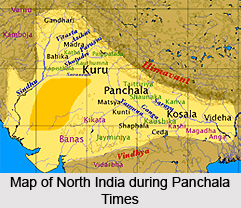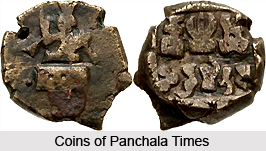 The Panchalas like the Kurus are most intimately connected with the Vedic civilisation of the Brahmana period. The Satapatha Brahmana tells that the Panchalas were called Krivis in the ancient times. Krivi appears as a tribal name in the Rig Veda. The Vedic
Literature has mentioned several Panchala kings. The Aitareya Brahmana says that Panchala kings had made extensive conquests in every direction. It is said that the first part of the name has been derived from the word Pancha which means five and it is believed that it has such a name because five tribes have been united into the Panchala tribe itself.
The Panchalas like the Kurus are most intimately connected with the Vedic civilisation of the Brahmana period. The Satapatha Brahmana tells that the Panchalas were called Krivis in the ancient times. Krivi appears as a tribal name in the Rig Veda. The Vedic
Literature has mentioned several Panchala kings. The Aitareya Brahmana says that Panchala kings had made extensive conquests in every direction. It is said that the first part of the name has been derived from the word Pancha which means five and it is believed that it has such a name because five tribes have been united into the Panchala tribe itself.
As per the details found in the Indian epics the Panchala country is divided into a northern and southern part so that the Panchalas had spread and had added to their country by conquest since the Vedic period. One of the earliest cities of Panchala was Parivakra or Parichakra, where the King Kraivya Panchala had performed his horse sacrifice. Another city which was of importance to the Panchalas was Kampila which has been mentioned in the Yajur Veda. The Vishnu Purana and the Bhagavata Purana has said that Kampila was the son of King Haryasva was celebrated as a Panchala King. Kampila on the other hand had become the capital of King Drupada when he was invested with the sovereignty of the southern Panchala country. In the Adikanda of Ramayana it has been said that King Brahmadatta used to live in the city of Kampilya.
 It has been found in several records that during the war of Kurukshetra Drupuda, king of the Panchalas had helped the Pandavas with his son Dhristadyumna. Dhrishtadyumna was the made the commander-in-chief of the entire Pandava force. The Panchala heroes were in the practice of using various kinds of horses during the war.
It has been found in several records that during the war of Kurukshetra Drupuda, king of the Panchalas had helped the Pandavas with his son Dhristadyumna. Dhrishtadyumna was the made the commander-in-chief of the entire Pandava force. The Panchala heroes were in the practice of using various kinds of horses during the war.
Panchala continued to be one of the great and powerful countries in Northern India down to the time when Lord Buddha lived. It is said that the Panchala had a large army consisting of foot soldiers, men skilled in fight and in the use of steel weapons. In the kingdom of Uttara Panchala in the city of Kampila there was a king named Dummukha. Dummukha on the other hand was the name of a powerful Panchala king of the Vedic period. Panchala and its princess also figure in the Jain literature. It is stated in the Uttaradhyayana Sutra that the king of the Panchalas did no fearful actions. The Jain writers also refer to Brahmadatta, king of Panchalas and to Dvimukha of Panchala who was a Pratyekabuddha.
Historical records states that in the post-Ashokan period Panchala was invaded by the Greeks. In the sixth and fifth centuries B.C, the Panchala were a monarchical clan but became a Sangha in the fourth century, when Kautaliya lived. Coins known as Panchala Mudra testify the presence of the Panchalas in the land of India. They generally weigh 250 grams and the smaller ones weigh around 16 grams. The coins of Panchala sometimes have on the obverse Agni with head of flames.





















